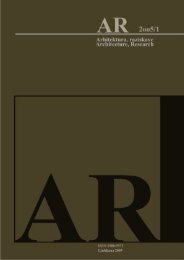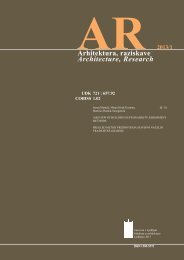VeÄ - Fakulteta za arhitekturo - Univerza v Ljubljani
VeÄ - Fakulteta za arhitekturo - Univerza v Ljubljani
VeÄ - Fakulteta za arhitekturo - Univerza v Ljubljani
Create successful ePaper yourself
Turn your PDF publications into a flip-book with our unique Google optimized e-Paper software.
4.11 RAZVOJ URBANIZMA NA SLOVENSKEM<br />
HISTORY OF URBANISM IN SLOVENIA<br />
IV. letnik 60ur<br />
obvezni predmeti compulsory subjects<br />
prof. dr. Fedja Košir, univ. dipl. inž. arh.<br />
- Košir, F.: Izbrani èlanki 1975/1999 (LJ, FA 2000)<br />
Vsebina: Uvod (znaèilnosti slovenskega poselitvenega prostora). Arheološko izroèilo od neolitika do <strong>za</strong>tona antike.<br />
Vprašanje o regionali<strong>za</strong>ciji (in standardnih nacionalnih fetiših). Fevdalna mesta in trgi na Slovenskem. Od fevdalnega<br />
do modernega tkiva. Maks Fabiani kot prvi moderni urbanistièni in arhitekturni naèrtovalec in teoretik (»in the field«).<br />
Trideseta leta in prodor funkcionalistiènih nazorov (1930/1940). Tradicionalizem vraèa udarec: Architectura Perennis<br />
(1941). Klavrna in kratka fa<strong>za</strong> socrealizma (1945/1950). Vrnitev k ciamovskemu funkcionalizmu (1950/1965).<br />
Strukturalistièna fa<strong>za</strong> funkcionalizma (1965/1980). Alternativno birokratsko planerstvo in ekosocializem (»urbanizem<br />
= matematika + marksizem«). Postmoderna kritika funkcionalistiènih dogem (1980/2000). Digitalia »pro futuro«.<br />
Rezervna tema (povzetek): urbane <strong>za</strong>snove dvajsetega stoletja.<br />
Contents: Introduction (characteristics of the space of Slovenian settlement). Archaeological heritage from the<br />
Neolithic till the demise of Classical Antiquity. Regionalisation issues (and standard national fetishes). Feudal cities<br />
and markets in Slovenia. From the feudal to the modern tissue. Maks Fabiani as the first modern urbanist, architect<br />
and theoretician (»in the field«). The thirties and the influx of functionalistic attitudes (1930–1940). Traditionalism<br />
strikes back: Architectura Perennis (1941): the meagre and short phase of Socrealism (1945–1950). Return to CIAM<br />
Modernism (1950–1965). Structuralistic phase of Functionalism (1965–1980). Alternative bureaucratic quasiplanning<br />
and Ecosocialism (»urbanism = mathematics + marxism«). Post-modern critique of functionalistic dogmas<br />
(1980–2000). Digitalia »pro futuro«. Reserve topic (summary): urban concepts of the 20th century.<br />
88 dodiplomski študij graduate course orientation: URBANISM

















